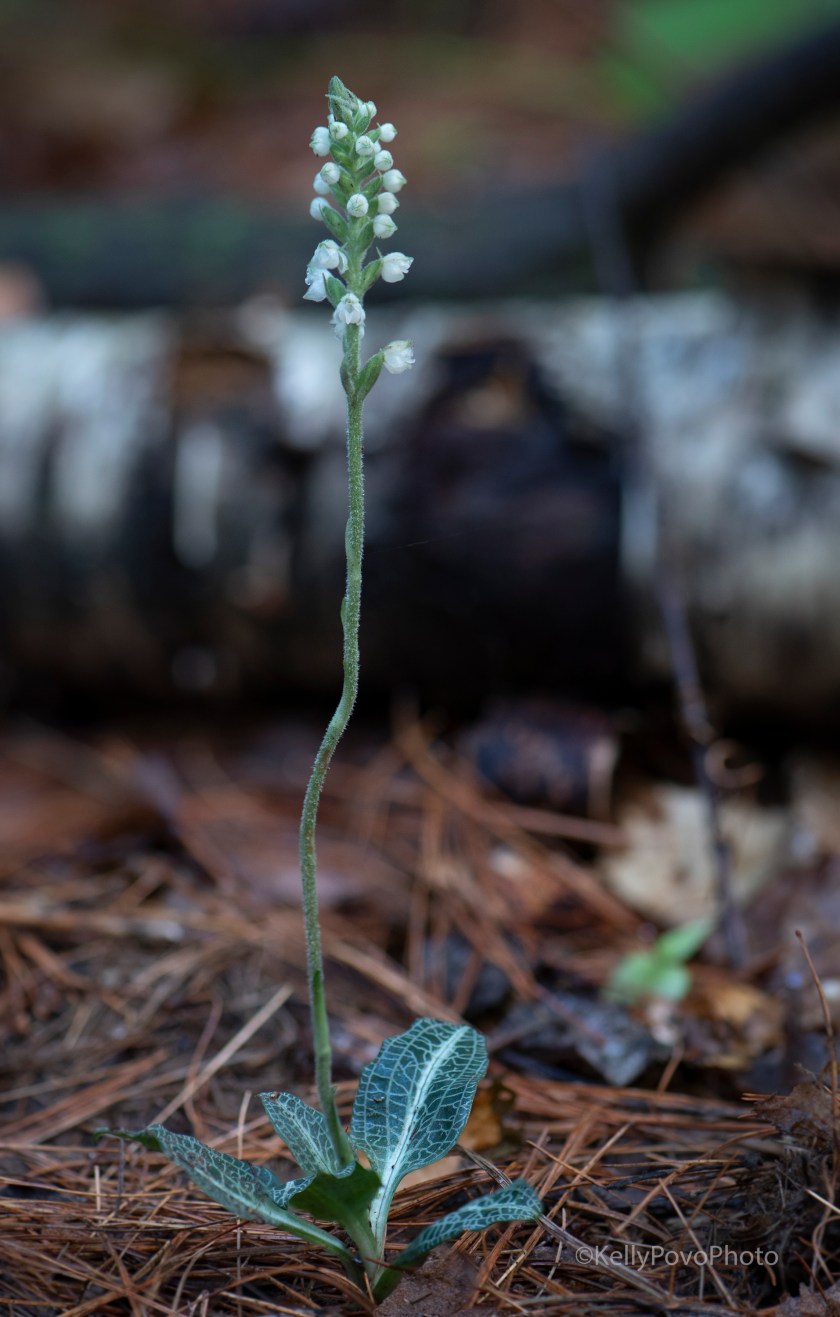July 24, 2021
Author: Phyllis Root
Photographer: Kelly Povo
Some days the gods and goddesses of wildflower chasers smile, and some days they chortle behind their hands. This past Saturday we’re pretty sure they did both. What began as a short morning visit to places about an hour from home became an all–day three-hundred-mile round trip search.
In the morning the deities smiled on us. A brief stop at Falls Creek Scientific and Natural Area (SNA) led us to many blooming downy rattlesnake plantain orchids, making this a kind of hat trick in which we’ve seen all three rattlesnake plantain orchids–downy, lesser, and tessellated–blooming in a single week. Then, following directions that a friend had shared with us, we drove to a cedar swamp along the St. Croix River and walked very, very carefully across pieces of a slippery, tilty boardwalk hoping to find at least one club spur orchid blooming. The sound of running water flowed through the swamp, raindrops hung on pine needles like droplets on sundew, and we felt as though we’d been transported to a rain forest. Not only did we find one club spur orchid, we found many–some gone to seed, some on their way to seed, some still brightly blooming.
Kelly had gotten GPS coordinates for a place near Virginia, Minnesota, where we could look for northern slender ladies’-tresses, another of the orchids on our still-to-see list, and we talked about making a trip north soon to look for the orchids. When we realized we were already about halfway to Virginia it seemed like a slam-dunk to just keep on driving. Neither of us had anything planned for the rest of the day, and, after all, we did have coordinates. All we had to do was drive the rest of the way to Virginia, hike to the coordinates, photograph the orchid, and drive home in time for supper.
At this point the wildflower-chaser deities chortled, and they didn’t stop laughing until about nine o’clock that night when at last we arrived back at our homes. When we got to Virginia we parked on a road near the dropped pin on Kelly’s phone, then hiked past huge dumpsters to a padlocked gate and a tall chain link fence topped with barbed wire. Clearly not the way in. The second road we tried led us through a waste management facility into a woods, past a steep ravine, and eventually back to the same dumpsters and the same locked chain-link fence.
Stymied, we drove around on back roads trying to get closer to the coordinates, but as the digits of one number on our compass app moved closer to the pin coordinates, the digits of the other number moved farther away. Up and down the roads we drove, up and down the numbers went. Finally, hot, hungry, and frustrated, we stopped for a late lunch and decided to read the directions we’d been given more carefully. Oh, we said as we munched, look at that. The directions tell us exactly where to park and start hiking. What a good idea to read them! Ever hopeful, we headed out for one more try.
Sure enough, following the directions exactly instead of randomly chasing after coordinates led us along a trail, up a rough road, and into a world growing out of what seemed to be an enormous rock pile left over from earlier nearby mining operations. How long had these rocks been piled here for mosses and lichens to colonize them, plants to take root, trees to have time to grow? Wondering, we walked along a dusty, rocky, red dirt path through a fascinating forest unlike any we’d ever seen, following a series of pink ribbons tied to branches, sure they would lead us at last to the orchids we had come to see. Even though finding the orchids no longer felt like a slam-dunk, we agreed we would settle for a slow dribble down the court and an easy lay-up of an orchid find.
We did see orchids: a stemless lady’s-slipper gone to seed and a past-its-prime orchid that was either a spotted coralroot or a western spotted coralroot. We’ve been trying to learn to differentiate between the two based on the shape of the flower lip, and we debated, undecided if this was the rectangular lip of a spotted coralroot or simply a shriveled egg-shaped lip of western coralroot. We came down on the side of spotted coralroot.
We were still far from reaching the coordinates of the sought-after orchid, and time and energy were both fading. Finally we turned, retraced our way down the trail, and headed back to the cities through slanting evening light. We know we’ll come again to this strangely magical world, both to keep searching for the orchid and also to marvel at this red-rock habitat reclaiming itself on what feels like the top of the world.
All in a mad dash north, we had found a new place to explore, realized that we really needed to learn more about using GPS coordinates, and seen four different kinds of orchid, although not the one we’d driven north to see. The wildflower gods and goddesses might have been laughing all the way home, but then so were we.
[A fellow wildflower searcher later verified that it was spotted coralroot that we saw, so we’ve added it to our list of orchids seen. Thanks so much to knowledgeable and generous wildflower folks!]

Downy rattlesnake plantain 
Club spur orchid 
Spotted coralroot


Your lede is so true! And it’s true of so many other things in life, too. Thanks for sharing your beautiful wildflower finds!